-
-
WHITEWATER
CANOEING
-
by Lynn Conway
-
Copyright @ 1999-2003, Lynn Conway.
-
All Rights Reserved

-
- My
husband and I met while canoeing near Ann Arbor, Michigan in 1987. We went
on to run many of Michigan's beautiful quietwater and quickwater rivers
together, and to doing a lot of whitewater canoeing and slalom racing too. We've enjoyed wonderful canoeing adventures for many years
now. This page tells a little bit about those adventures.
-
- If you'd like to
learn more about quietwater canoeing, whitewater canoeing
and slalom racing, there are excellent websites you can explore. The
American
Canoe Association (ACA) web-site provides
linformation on all aspects of paddling. The
NOC site provides
information on their outstanding whitewater canoeing and kayaking
instructional courses. Paddling.net is a great link into buyer's guides to
canoeing equipment, lists of outfitters and paddling schools, etc. The
East Race and
Wausau
Raceway sites provide information on
whitewater slalom practice and slalom racing events at those whitewater
raceways.
-
-
-
- Getting started in canoeing:
-
- When I first moved to Ann Arbor in
1985, I was delighted by the
Huron River and the beautiful parks
and woodlands along it. I rented a canoe and paddled several
sections. Wow, this was great! I then bought a kevlar Curtis
"Vagabond" from CanoeSport in Ann Arbor (a wonderful canoeing
enthusiasts' store that's since closed), and began
exploring many of
Michigan's
rivers in this sleek, fast, lightweight solo canoe. The
beauty of these rivers is incredible, with quick-moving, shallow
water running over sandy bottoms, winding their way for scores
of miles through wooded, mostly undeveloped landscapes.
They provide an excellent environment for learning basic and then more
advanced canoeing skills, and in a setting that really soothed the soul.
-
-
- Lynn in her
Curtis Vagabond on the Huron
River in Ann Arbor, MI October
1986
-

-
-
-
- There
are many canoe liveries in Michigan
where you can rent canoes to explore these rivers, and also pre-arrange
car drop-offs or return shuttles. However, if you get really
hooked on canoeing, you'll find that paddling in smaller "one-person"
solo canoe has lots of advantages even when touring in groups.
It's just more fun to have everyone in their own boat, free to
explore and play at whim. At that point you'll greatly benefit
from owning your own fast, sleek solo canoe.
-
-
-
- Exploring Michigan's rivers in a solo open canoe,
1987
-
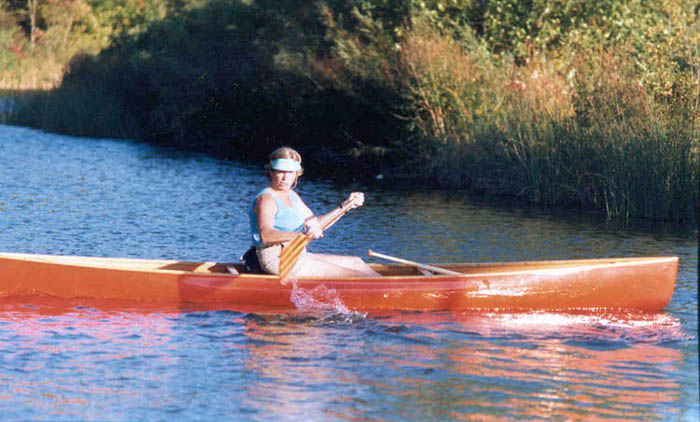
-
-
-
- For someone who had done lots of hiking, backpacking and
climbing, canoeing was a wonderful way to re-experience the out-of-doors:
silently moving along, leaving no trail, able to move closer-up
to wildlife, and finding all sorts of special places only accessible
from the water.
-
-
-
-
- A Special Place
-
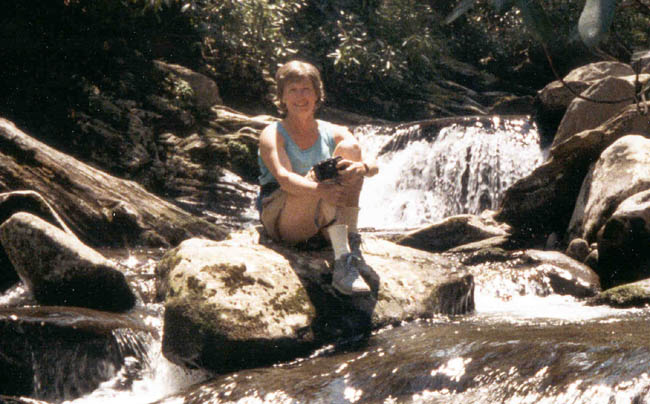
-
-
-
- Moving on to whitewater canoeing:
-
-
The Michigan quickwater rivers
can teach you a lot about paddling. But they can also get you
interested in trying bigger water. I decided to go take an intensive
whitewater paddling course at "Whitewater Specialty"
on the Wolf River in Wisconsin. Wow! Was that ever cool! I'd
just met Charlie while canoeing in Michigan, and we both then
went to an intensive intermediate course at Nantahala
Outdoor Center (NOC) on the Nantahala River in North Carolina.
In the mid-to-late 1980's, solo canoe design was progressing
very rapidly, and paddlers were running rivers in the new solo
open canoes that previously had only been run in decked boats (kayaks).
It turned out by great coincidence that the city of South Bend, Indiana -
only 3 hours away from Ann Arbor- had recently opened an artificial
whitewater course (the
East
Race Waterway) that was open to the public for practice sessions on
summer weekends. Charlie and I began to exploit that waterway on many summer
weekends to build our skills at technical whitewater paddling.
-
-
- Lynn practicing her whitewater paddling techniques at
East
Race Waterway, South Bend, IN
-
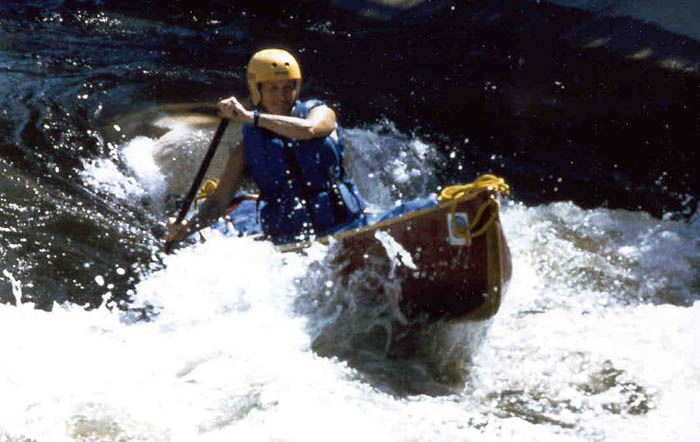
-
-
-
- In order to learn, you have to
make a lot of mistakes:
- Here Lynn is caught in the act,
about to go for a swim. Check out that solid "air brace"!
-
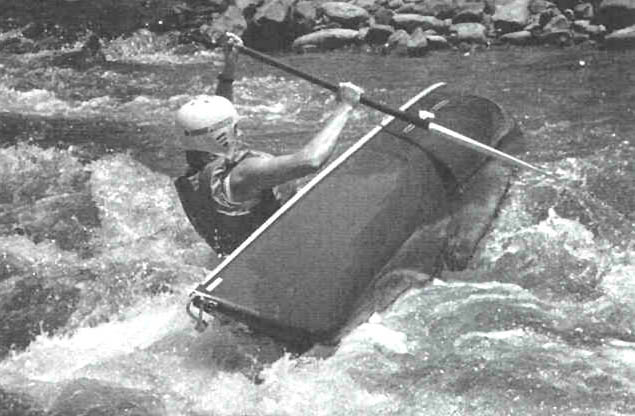
- This photo is from the
Canoeing
guide to Western Pennsylvania and Northern West Virginia
by
Roy
Weil & Mary Shaw (Mary is Prof. of CS at CMU)
-
-
-
- Over the next few years, we
did lots of whitewater paddling. Whitewater canoeing is inherently a very
social experience, since you can't do it alone. You've got to have safety in
numbers, to provide protection for each other at difficult places along the
way, and to rescue anyone who gets into difficulty. We looked for
and found many great canoeing companions, and shared wonderful
experiences with them on rivers all across Wisconsin,
Western Pennsylvania, North Carolina, Tennessee and Georgia.
-
-
- Lynn running
Slippery
Rock Creek (more), in
McConnells Mill State Park NW Pennsylvania
-

-
-
-
-
- Lynn in another canoe on a later
run of Slippery Rock Creek
-

-
-
-
-
-
Lynn running Frank Bell's Rapid
on the French Broad River, North Carolina,
On a run from
Barnard to Hot
Springs, May 1988
-
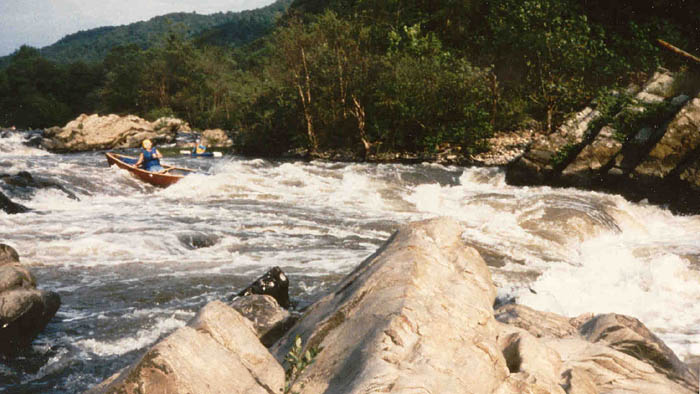
-
-
-
-
- Lynn running Kayak Ledge on the
French Broad, May 1988
-
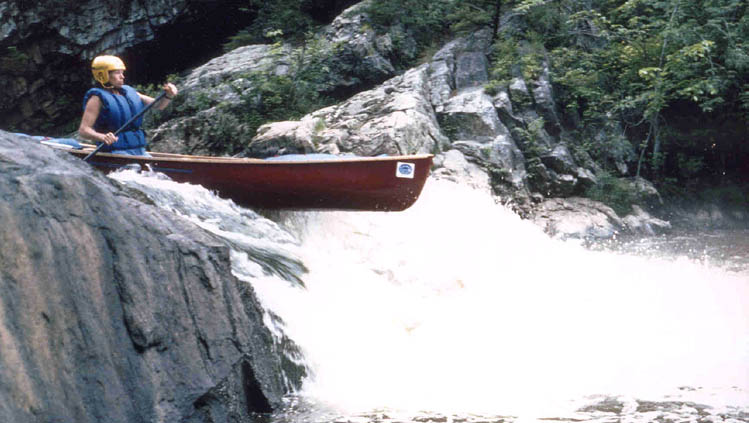
-
-
-
-
- River's End Rapid,
Lower
Yough River, Western Pennsylvania, in Oct. 1988
- Lynn is in the distance, partway down thru the
rapid.
-
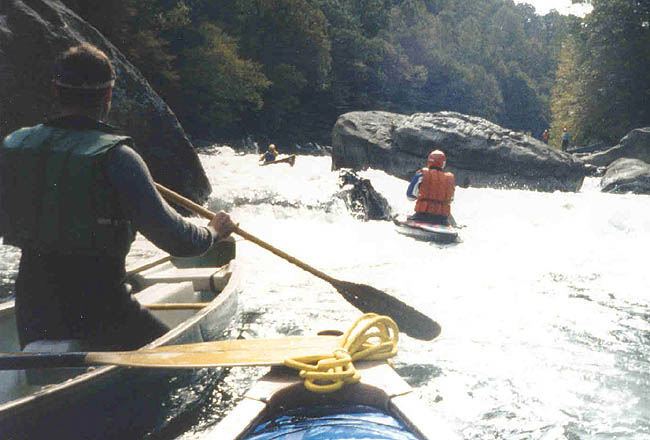
-
-
-
- Learning slalom racing and entering race
events:
-
- Some of our
canoeing friends had done
whitewater slalom racing and said it was a great experience,
so we gave it a try. We took whitewater slalom racing instruction
at NOC in North Carolina and at Whitewater Specialty in Wisconsin, and then
did more practicing
at the East
Race Waterway, the artifical whitewater raceway in South Bend,
Indiana. We went on to participate in slalom races at the
whitewater raceway in Wausau, Wisconsin,
where the
American
Canoe Association
(ACA) held the White-water Open
Canoe (WWOC) National Championships (more). Slalom racing pushes
you to develop skills and methods for boat control in ways that
river running just doesn't do, and can tremendously
enhance one's overall paddling experience.
-
-
-
WWOC Slalom
racing:
Lynn runs the gate in the Big
Drop at Wausau, Wisconsin in June
1991
-
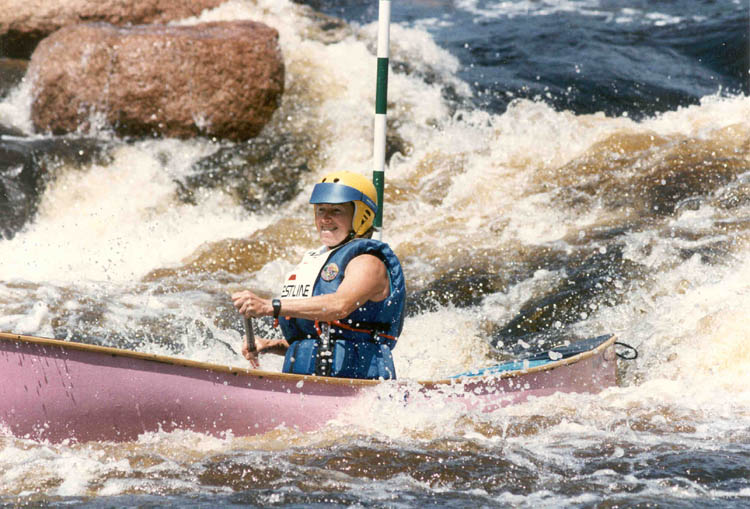
-
-
-
- WWOC Slalom
racing:
- Charlie setting up to enter the
gate just below the Big Drop, Wausau, WI
-

-
-
-
- Lynn maneuvering towards a gate
during a slalom race at Wausau, June 1991
-

-
-
- Slalom racing at the Wausau
Whitewater Raceway:
-
- The Wausau
Whitewater Raceway is an "enhanced natural whitewater course"
that was created
by augmenting an old natural rapids with many boulders and rock berms. The
result is an amazingly complex and challenging series of pools, drops and
holes that provide many opportunities of highly technical paddling,
especially when "gates" are placed along the way.
The race course is fed from a dam, with releases adjustable to
various flow rates. It's
a great place for slalom racing.
-
- You'll find a detailed
map of the Wausau Whitewater Park and a
topo of the Whitewater Raceway below. For more
information on the raceway, check out the
Wausau
Canoe/Kayak Corporation website. Note that they hold training sessions
(for both canoeing and kayaking) that are open to all levels of paddling
skill, and the raceway itself is open a number of times each summer for
practice paddling on its highly technical water. Their website contains
detailed info on these training sessions, open practice sessions and
competition events.
-
- We entered the American Canoe Association's National and Divisional Championship races at Wausau in '89, '90, '91, '92
and '93. These White-Water
Open Canoe (WWOC) races were divided into a number of classes, as follows.
-
- Solo boats
(with one paddler) are designated OC1, while tandem boats (two paddlers) are
designated OC-2. The classes were also divided into one set for the heavier
production river-running boats (R) and another for more specialized ultra-lightweight competition boats (C). There were also separate classes for men
(M) and women (W), although sometimes women who put in high
scores were given awards in the "overall" rankings (as in '93).
-
- In addition to the
slalom races, so-called "combined" races were run at some Wausau
championships (as in 1989). Combined events merge the results of two
separate races, (i) a
whitewater slalom race on the Wausau raceway, and (ii) a downriver whitewater
race on the nearby Red River, in order to obtain overall scores for the event.
Here's a summary of our results for the '89 - '93 seasons, with codes for
the classes we raced in:
-
-
| ACA WWOC Race Event |
Charlie's results |
Lynn's results |
| '89 National Championships
|
- OC-1M Senior R: 8th
- OC-1M Open: R 18th
- OC-1M Combined R: 10th
|
- OC-1W Masters R: 1st (Gold)
- OC-1W R: 1st (Gold)
- OC-1W Combined R 2nd (Silver)
|
- '90 Midwest Divisionals
|
OC-1M R: 8th |
- OC-1W R: 1st (Gold)
|
- '91 National Championships
|
OC-1M R: 13th |
OC-1W R: 3rd (Bronze) |
- '92 Midwest Divisionals
|
OC-1M R: 7th |
OC-1W R: 1st (Gold) |
- '93 National Championships
|
OC-1M R: 7th OC-1M
C: 7th |
OC-1W R: 1st (Gold)
OC-1 Masters
overall R: 2nd (Silver) |
Map of the Wausau Whitewater Park:
The starting area is at the right, and the finish is at the
left.
[click on map
for higher-resolution version]
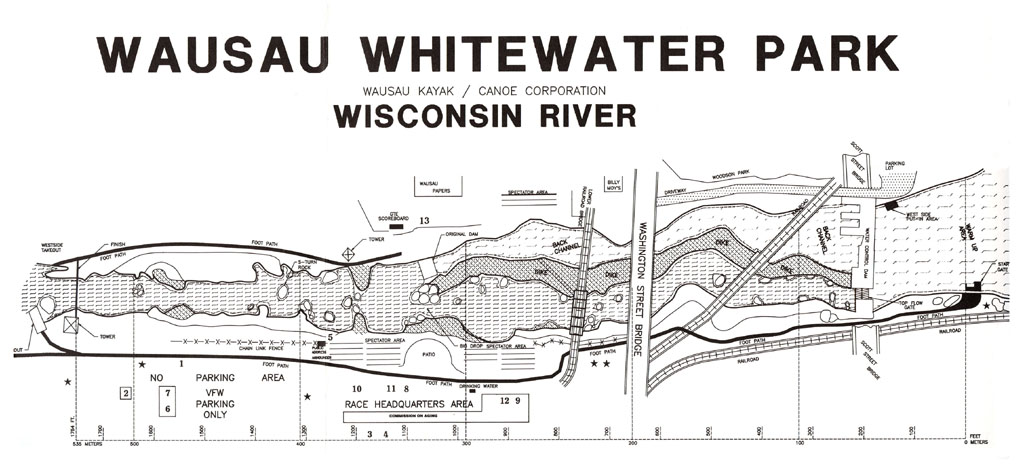
Topo of the Wausau Whitewater Raceway:
Showing gate placements for the 1993 WWOC Nationals.
This topo of the Wausau Whitewater
Raceway is sketch in two sections, and shows the gate placements for one of the
races. The starting area is at the top of the left-hand section. That end of
that section then continues at the top of the right-hand section, and the finish
line at the bottom of the right hand section. The start of the canoe races
is shown just below the Scott Street Bridge. The locations of the 25 gates are
sketched in this topo, with the direction of passage through each gate is shown
by arrows. Gates labeled with "R's" had to be run in "reverse", i.e., stern
first.

Updated 1-14-07
![]()
![]()













